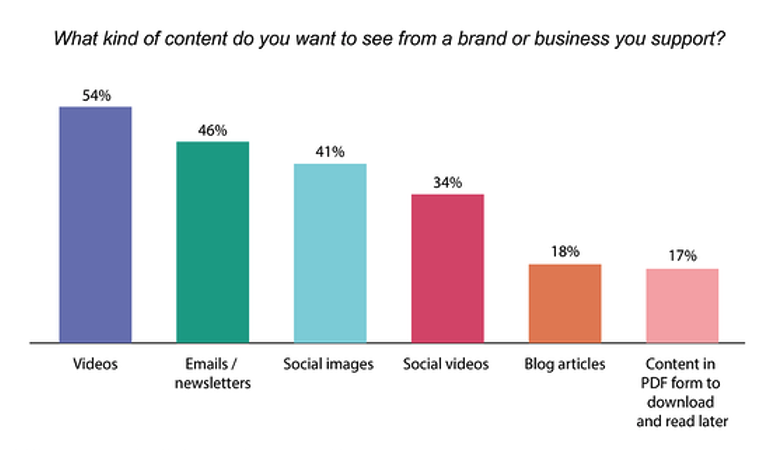YouTube. TikTok. Facebook. Snapchat. Instagram. What do all of these various social platforms have in common? Today, they’re one of your greatest assets when it comes to video advertising. It’s an ever-evolving method that only grows more important with each passing year.
So much so, that media agency Zenith predicted a decline in US TV ad spending in 2021. As the television audiences continues to shrink, more marketers are investing their money in online video. In 2021, total TV spending shrunk by 4% to $60.575 billion from $63.4 billion in 2020.
While this isn’t the most staggering shift, it is a sign that, no matter the speed, times are changing, and so is how we consume advertising. And it won’t stop anytime soon.
Why? According to HubSpot research, more than 50% of consumers WANT to see videos from brands versus any other type of content:

Here is why video advertising is so important for your college or university.
Have You Heard of the “TikTok Effect”?
When TikTok first came on to the scene, it followed in the footsteps of many of its social media siblings (i.e., Snapchat, Instagram, etc.). Yet, TikTok prioritized video content in such a way that users would spend HOURS scrolling through short videos.
There’s a simple, unspoken rule when it comes to social media: “If something works, steal it.” It didn’t take long before Instagram followed suit with “Reels” and YouTube came out with “YouTube Shorts”.
Now, every platform is looking for ways to incorporate video. For the individual content creator, this is a fun development. More content tends to put emphasis on quantity over quality – perfect for the person whose professional camera doubles as their phone.
But, for larger organizations, colleges or universities, this creates a demand for video content that they’ve never experienced before. Before, a school could get away with creating a 30 second TV spot, cut it down to a couple of 15-second spots, and run the ads on broadcast and maybe social media.
Today, a more accurate video assent inventory looks a little something like this:
- 1 x 0:30 Video Ad (Broadcast & OTT)
- 4 x 0:15 Video Ads (YouTube Pre Roll, Facebook, Instagram)
- 8 x 0:10 Vertical Video Ads (TikTok, Snapchat, Instagram Stories)
A key as to what makes social media so popular amongst the growing population is personability. When someone is online – they’re exploring the world through a filter. Their filter. They subconsciously desire ads and media that suit and attract them, so it’s important when developing content that’s meant to engage is to make them for your different target audiences.
Creating video ads for different target audiences will create more relevancy in your marketing messaging.
Before we define your target audience, we need to know where you might find them. It’s important to understand network demographics. Khoros reports that:
- 54% of Facebook users are female
- 93% of Facebook users access it from a mobile device
- 23% of Instagram users are between the ages of 50 & 64
- 81% of people 18 – 25 use YouTube
- Over 70% of YouTube views are on mobile devices.
With that in mind comes another question: who is your target audience or audiences?
For colleges and universities, it would be safe to assume “prospective students” are the answer, yet that’s an umbrella term that can include:
- Undergraduate
- Graduate
- PhD
- Part-time
- International
- Transfer
- Current
While the endgame for all students across the board is relatively the same (to earn an education), we need not to focus on the destination as much as we do their journey to get here.
You wouldn’t advertise to a current student to come back next year the same way you would to a student who’s considering a transfer. You’re talking to one with experience at your school versus one with none.
However, some do share similar journeys; while someone who’s looking to transfer has more likely been on a college campus, they don’t know your campus – kind of like a potential freshman. Creating fun, informative videos that highlight the very best your campus has to offer would benefit both kinds of student.
This would be hard to compile all into a simple TikTok, however you could create a tighter, impactful ad promoting that you offer this type of experience – you should also offer a link to the longer, more in-depth YouTube or Instagram reel. Make it engaging, easy and relevant.
And believe it or not, your video content doesn’t always need a large production behind it.
That’s right.
The expectation of video quality has changed.
Today, not every video needs the highest quality. In fact, the more “hand-held”, user generated video content can be just as – if not more, successful as a professionally created 30-second video spot.
User generated content can be more effective at driving engagement. According to Webpurify, 90% of consumers find UGC helpful. That’s because they’re more inclined to believe what an existing customer posts about a brand versus a flashy promotion.
A study by Comscore reports that customer engagement is around 28% higher with UGC than something professionally produced.
41% of TikTok users are between 16 and 24-years old, which is the prime demographic for Higher Ed.
Here’s an example of a few universities utilizing social media to represent what they’re about:
- The University of South Dakota (TikTok): https://www.tiktok.com/@usouthdakota
- The University of Alabama (Instagram): https://www.instagram.com/univofalabama/
- The University of Florida (TikTok): https://www.tiktok.com/@uf
In short, video is everywhere, whether it be professionally produced, or user generated, so why not capitalize on the trend? It’s not going anywhere. By going with it, you can appeal to all your demographics, create personal content and engage with prospective students. It’s where most of them are at, and if you can meet them there, their chances of trusting and going with you are that much stronger.



